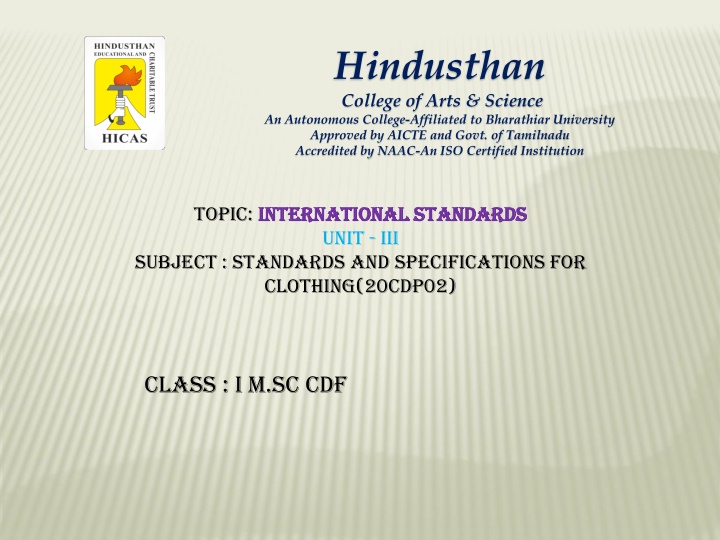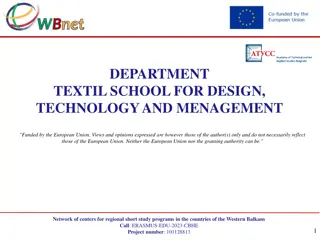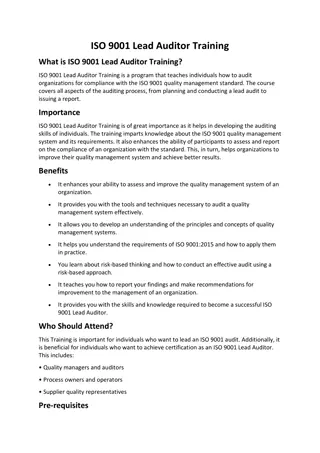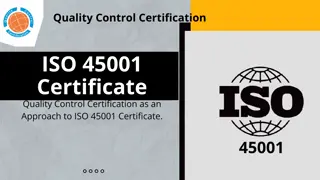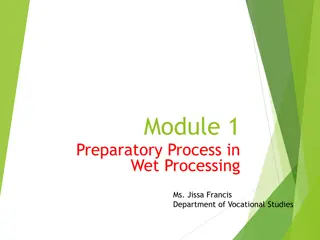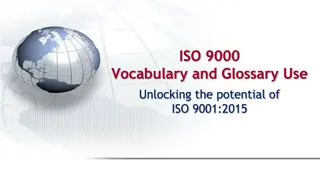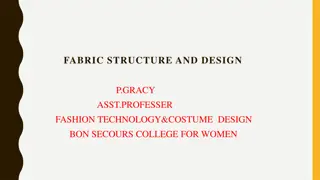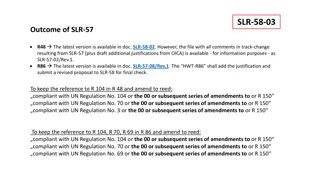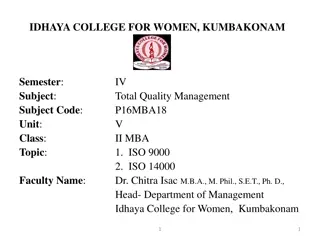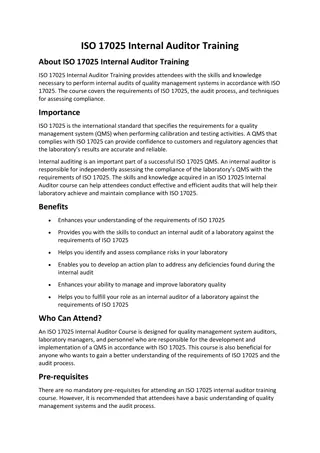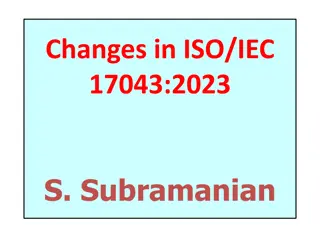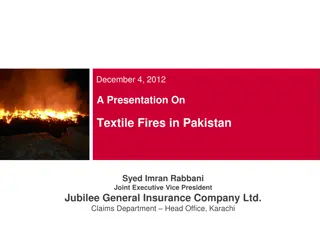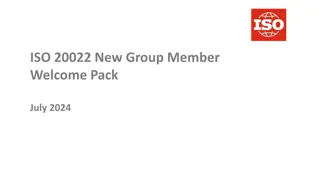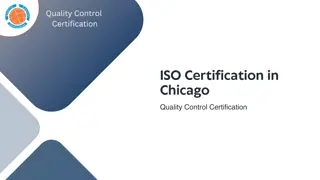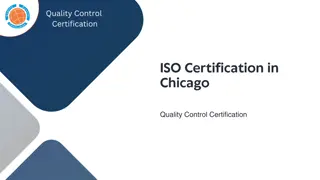ISO in Textile Industry Overview
ISO in the textile industry ensures consistent quality production methods and finished goods. Learn about ISO's role in setting international standards for textile testing, covering various aspects of production.
Download Presentation

Please find below an Image/Link to download the presentation.
The content on the website is provided AS IS for your information and personal use only. It may not be sold, licensed, or shared on other websites without obtaining consent from the author.If you encounter any issues during the download, it is possible that the publisher has removed the file from their server.
You are allowed to download the files provided on this website for personal or commercial use, subject to the condition that they are used lawfully. All files are the property of their respective owners.
The content on the website is provided AS IS for your information and personal use only. It may not be sold, licensed, or shared on other websites without obtaining consent from the author.
E N D
Presentation Transcript
Hindusthan College of Arts & Science An Autonomous College-Affiliated to Bharathiar University Approved by AICTE and Govt. of Tamilnadu Accredited by NAAC-An ISO Certified Institution TOPIC: INTERNATIONAL STANDARDS INTERNATIONAL STANDARDS Unit - IiI SUBJECT : STANDARDS AND SPECIFICATIONS FOR CLOTHING(20CDP02) Class : I M.SC CDF
WHAT IS ISO IN TEXTILE INDUSTRY? WHAT IS ISO IN TEXTILE INDUSTRY? ISO is an acronym that stands for the International Organization for Standardization. ... ISO textile testing standards cover many aspects of international textile production. ISO textile testing standards are a wide range of guidelines developed to ensure consistent quality production methods and finished goods made in the textile industry. ... ISO guidelines cover management systems, regulatory issues, customer needs and can help improve performance.
INTRODUCTION INTRODUCTION The International Organization for Standardization widely known as ISO is an international standard-setting body composed of representatives from various nationalstandards organizations. Founded on February 23, 1947, the organization promulgates worldwide proprietary, industrial, and commercialstandards. It has its headquarters inGeneva, Switzerland
INTRODUCTION INTRODUCTION The organization today known as ISO began in 1926 as the International Federation of the National Standardizing Associations (ISA), whose focus was mainlymechanical engineering. It was disbanded in 1942 during World War II but was reorganized under its current name, ISO, in 1946, in London and the new organization officially began operations in February 1947.
INTRODUCTION INTRODUCTION ISO is a voluntary organization whose members are recognized authorities on standards, each one representing one country. The bulk of the work of ISO is done by the 2,700 technical committees, subcommittees, and working groups. Each committee and subcommittee is headed by a Secretariat from one of the member organizations.The three official languages of the ISO areEnglish, French, and Russian.The organizations logos in two of its official languages, English and French,include the word ISO, and it is usually referred to by this short-form name
ISO 9000 STANDARDS ISO 9000 STANDARDS The ISO 9000 family of standards is related to quality management systems and designed to help organizations ensure that they meet the needs of customers and other stakeholders while meeting statutory and regulatory requirements related to the product. The standards are published by ISO, the International Organization for Standardization, and available through National standards bodies. ISO 9000 deals with the fundamentals of quality management systems, including the eight management principles on which the family of standards is based. ISO 9001 deals with the requirements that organizations wishing to meet the standard have to fulfil.
HISTORY HISTORY ISO 9000 was first published in 1987. It was based on the BS 5750 series of standards from BSI that were proposed to ISO in 1979. However, its history can be traced back some twenty years before that, to the publication of the United States Department of Defence MIL-Q-9858 standard in 1959. MIL-Q-9858 was revised into the NATO AQAP series of standards in 1969, which in turn were revised into the BS 5179 series of guidance standards published in 1974, and finally revised into the BS 5750 series of requirements standards in 1979 before being submitted to ISO.
HISTORY HISTORY ISO 9000: had the same structure as the UK Standard BS 5750, with three 'models' for quality management systems, the selection of which was based on the scope of activities of the organization: ISO 9001: Model for quality assurance in design, development, production, installation, and servicing was for companies and organizations whose activities included the creation of new products. ISO 9002: Model for quality assurance in production, installation, and servicing had basically the same material as ISO 9001 but without covering the creation of new products.
HISTORY HISTORY ISO 9003: Model for quality assurance in final inspection and test covered only the final inspection of finished product, with no concern for how the product was produced. ISO 9000: 1987 was also influenced by existing U.S. and other Defence Standards ("MIL SPECS"), and so was well-suited to manufacturing. The emphasis tended to be placed on conformance with procedures rather than the overall process of management, which was likely the actual intent.
HOW MANY ISO STANDARDS ARE HOW MANY ISO STANDARDS ARE THERE? THERE? Because ISO strives to standardize business processes and procedures around the world, it has published more than 22,700 standards. For instance, the ISO 9001 standard contains guidelines for establishing and maintaining a quality management system (QMS)
PURPOSE OF ISO STANDARDS PURPOSE OF ISO STANDARDS The ISO plays an important role in facilitating world trade by providing common standards among different countries. These standards are intended to ensure that products and services are safe, reliable, and of good quality
BENEFITS OF ISO INTERNATIONAL BENEFITS OF ISO INTERNATIONAL STANDARDS STANDARDS ISO International Standards ensure that products and services are safe, reliable and of good quality. For business, they are strategic tools that reduce costs by minimizing waste and errors and increasing productivity. They help companies to access new markets, level the playing field for developing countries and facilitate free and fair global trade. Identify risks and opportunities. ... Prevent problems from reoccurring. ... Boost your marketing and sales efforts. ... Improve employee performance. ... Improve your control over the business
WHO IS USING THEM? WHO IS USING THEM? Corporations around the world have been building and continue to build their quality systems around these standards. Both large and small companies with international businesses perceive the ISO 9000 series as a route to open markets and improved competitiveness. One doesn t have to be a multinational corporation to benefit from implementing these standards.
FUNCTIONS OF ISO STANDARDS FUNCTIONS OF ISO STANDARDS The International Organization for Standardization (known as the ISO for short) is a global organization that works to provide standardization across an array of products and companies. Its main goal is to facilitate trade, but its focus is on process improvement, safety, and quality in several areas.
WHAT DOES BEING REGISTERED TO WHAT DOES BEING REGISTERED TO ISO 9001 OR 9003 MEAN? ISO 9001 OR 9003 MEAN? It means having an accredited independent third party conduct, an on-site audit of your company s operations against the requirements of the appropriate standard. Upon successful completion of this audit, your company will receive a registration certificate that identifies your quality system as being in compliance with ISO 9001, 9002 or 9003. Your company will also be listed in a register maintained by the accredited third- party registration organization (called registrar). You may publicize your registration and use the third party registrar s certification mark on your advertising, letter heads, and other publicity materials, but not on your products.
ADVANTAGES ADVANTAGES It is widely acknowledged that proper quality management improves business, often having a positive effect on investment, market share, sales growth, sales margins, competitive advantage, and avoidance of litigation. The quality principles in ISO 9000:2000 are also sound, according to Wade and also to Barnes,who says that "ISO 9000 guidelines provide a comprehensive model for quality management systems that can make any company competitive.
ADVANTAGES ADVANTAGES " Implementing ISO often gives the following advantages: 1. Creates a more efficient, effective operation 2. Increases customer satisfaction and retention 3. Reduces audits 4. Enhances marketing 5. Improves employee motivation, awareness, and morale 6. Promotes international trade 7. Increases profit 8. Reduces waste and increases productivity 9. Common tool for standardization.
ISO 14000 STANDARDS ISO 14000 STANDARDS ISO 14000 is similar to ISO 9000 quality management in that both pertain to the process of how a product is produced, rather than to the product itself. The requirements of ISO 14000 are an integral part of the European Union s Eco- Management and Audit Scheme (EMAS). EMAS s structure and material requirements are more demanding, foremost concerning performance improvement, legal compliance and reporting duties. The ISO 14000 family consists of standards relating to environmental management systems (EMS) and others which are tools to help the organization realize its environmental policy, objectives and targets, and classify them by application:.
ISO 14000 STANDARDS ISO 14000 STANDARDS At the organizational level (implementing EMS, conducting the environmental auditing and related investigations, and evaluating environmental performance). To Products and services (using environmental declarations and claims, conducting life cycle assessment), addressing environmental aspects in product standards, and understanding terms and definitions). ISO 14000 is a family of standards related to environmental management that exists to help organizations
ISO 14000 STANDARDS ISO 14000 STANDARDS (a) Minimize how their operations (processes etc.) negatively affect the environment (i.e. cause adverse changes to air, water, or land); (b) Comply with applicable laws, regulations, and other environmentally oriented requirements, and (c) Continually improve in the above.
LIST OF ISO 14000 STANDARDS LIST OF ISO 14000 STANDARDS ISO 14001 Environmental management systems Requirements with guidance for use ISO 14004 Environmental management systems General guidelines on principles, systems and support techniques ISO 14015 Environmental assessment of sites and organizations ISO 14020 series (14020 to 14025) Environmental labels and declarations ISO 14030 discusses post production environmental assessment ISO 14031 Environmental performance evaluation Guidelines ISO 14040 series (14040 to 14049), Life Cycle Assessment, LCA, discusses pre-production planning and environment goal setting.
ISO 14000 STANDARDS ISO 14000 STANDARDS ISO 14050 terms and definitions ISO 14062 discusses making improvements to environmental impact goals. ISO 14063 Environmental communication Guidelines and examples ISO 14064 Measuring, quantifying, and reducing Greenhouse Gas emissions.
WHO CAN USE ISO 14000 SERIES? WHO CAN USE ISO 14000 SERIES? ISO 14000 standards are implemented by thousands of organizations internationally. It is most widely used in the private and public sectors and by large organizations, but it can also be used by small and medium sized organizations and the social enterprise sector.
POTENTIAL BENEFITS POTENTIAL BENEFITS ISO 14000 covers a wide range of requirements that may go beyond compliance and legislation in seeking to improve the quality of the organization s environmental management activities. ISO 14000 is one of the most nationally and internationally known environmental standards that affirms the independent approval of a management system designed specifically to deliver high levels of customer satisfaction ISO 14000 can help organizations reduce waste, energy use and resources that can help to reduce costs. It has the potential to improve internal and external assurance and communication of management and environmental impacts.
POTENTIAL LIMITATIONS POTENTIAL LIMITATIONS Pursuing the Standard has the potential to be expensive in terms of start-up and running costs can be time consuming to implement There is less flexibility than other tools and it is much more difficult to use in smaller parts or for single issues. Although it is used in a variety of public and private sector organisations, there are few examples of other social enterprises that have used the Standard and therefore implementing and drawing upon other organisations experiences and making comparisons may be difficult. Elements of the management standard may pose difficulties in implementing within non-hierarchical organization s or non-traditional working structures such as co-operatives.
THANK YOU THANK YOU
